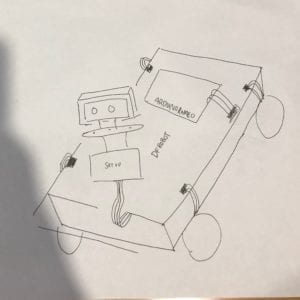CONCEPTION AND DESIGN:
In our original idea, we planned to build a car that was going to run around the room and the user needed to chase it in order for them to break the habit of staying on social media. We understood that the car may encounter some obstacles along its path, so we included an ultrasonic sensor. This way, the car would turn every time it it bumped into a chair or table. The car itself was too wide for the sensor to detect obstacles in its blind spots. To accommodate for this, we built a stand on top of the servo motor so it would be able to better detect the obstacles. Since we have changed the goal of the project to pull the laptop away from the user, the we attached wheels to the bottom of the laptop to prevent any damages. We understand that in the real world, this would not be practical for daily use, however it is incorporated it as a part of our overall statement that people should use social media less.
Our materials included: D Robot kit, Arduino Romeo, Wires, Ultrasonic sensor, Servo motors, 3D printed stand. We used the DFRobot kit because it was more efficient than building a car from 3d printing amongst other materials. We used the Arduino Romeo because it had more ports so there was less of a need for a breadboard. The Ultrasonic sensor was used to detect objects , the Servo motor was used to rotate the sensor around to detect objects in its blind spots. We 3D printed a stand for the Ultrasonic sensor to attach it to the servo motor. It allowed the sensor to stay upright and be more stable. Lastly, we laser cut some wood to make the robot look more like a car (covering the wires). These materials were the best suited for our projects purpose because they were practical to use and would exist in a real life setting. Another option would be 3D printing the car and attaching bottle caps to the sides as wheels. The car could have had a cleaner look, however it would be inefficient and very time consuming.
FABRICATION AND PRODUCTION:
In terms of success, we successfully build a robot that had all its components working and running. The P5 code required a lot of work however it worked fine. The real challenge was implementing bluetooth into both the robot and P5. We could not find detailed instruction on how to make it work, and even though we found some documentation, we were unable to incorporate it after hours of coding it. During user testing session, the robot stopped working and we were unable to get valuable feedback because the users were not able to truly experience our project. However, we did incorporate wheels to the bottom of the laptop to make the pull easier. This was an effective suggestion but not practical. We did not have to make too many decisions regarding its design. We followed the very basic design that came with the robot kit. The only modifications we made were to incorporate other important machine parts like the servo and sensor.

CONCLUSIONS:
The original goal of our project was to get users to get off of facebook and run around the room to chase the car. It would give them some exercise and remind them to get off of social media. However, the new goal of the project was to make a statement to the user, that there would be a physical pulling of your computer if they spent too much time on facebook. This project aligns with our definition of interaction because we believe that interaction is the series of movements by at least two actors, both responding to one another. Although the user is interacting with facebook, it is not a good type of interaction. However, the robots response to this “bad” form of interaction reminds the user to interact with the world around them. If we had more time, my partner and I would definitely incorporate the bluetooth function to make the original project work. From the setbacks we faced, my partner and I learned how to better improvise for our project to see what was the best fit for our situation. There was no way we would have made the robot work with the bluetooth function with the amount of time and resources that we had. This project really tested our patience but at the same time, we both learned so much about out ability to time manage and use new functions within our project.
In terms of the purpose of the project, it mattered a lot to the both of us because we wanted to be creative while making a statement. People should care about this project because it serves a message to the current generation and generations to come. I challenged myself because I was able to code everything from the beginning to end, and did not model it after code online.